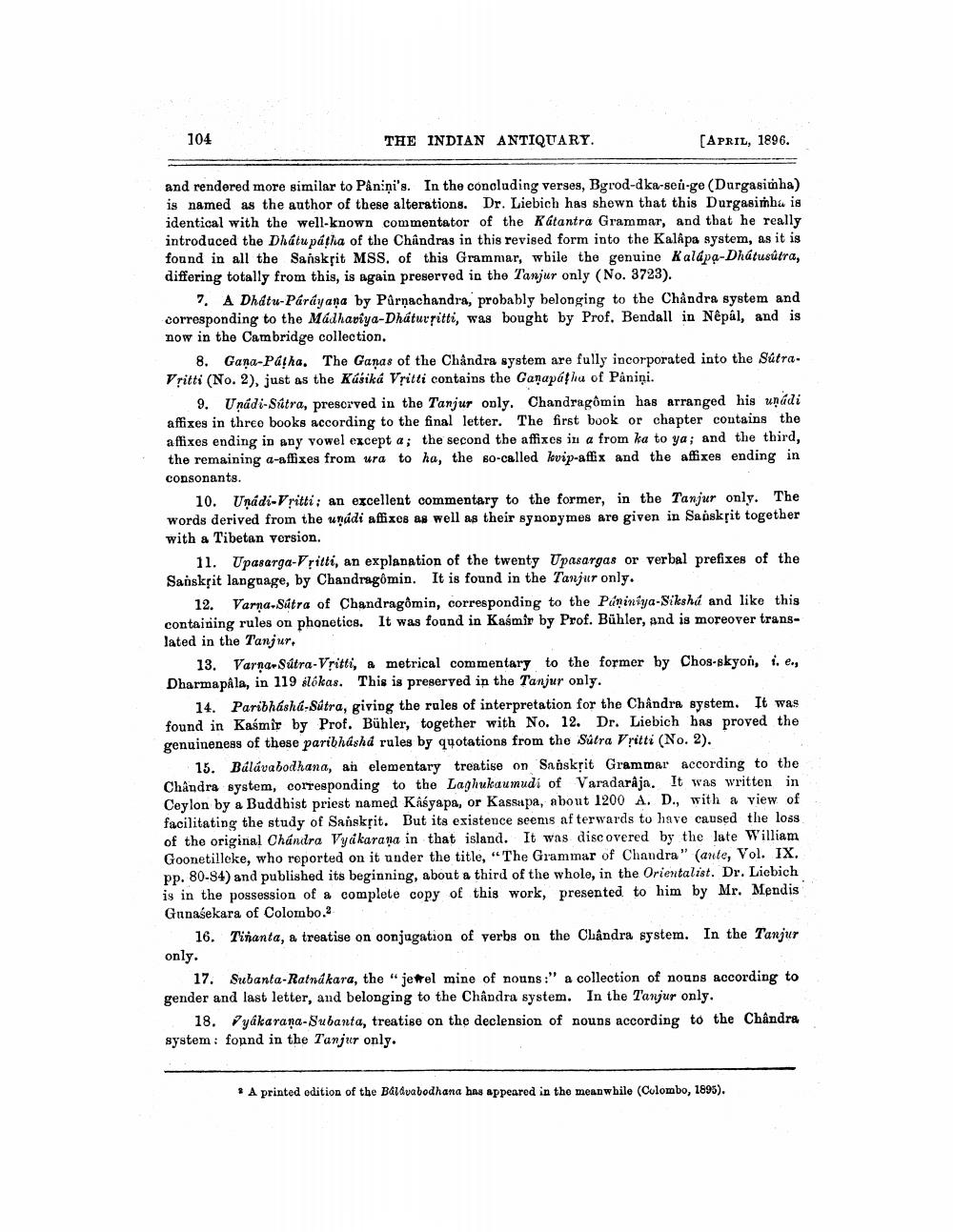________________
104
THE INDIAN ANTIQUARY.
[APRIL, 1896.
and rendered more similar to Pânini's. In the concluding verses, Bgrod-dka-sen-ge (Durgasimha) is named as the author of these alterations. Dr. Liebich has shewn that this Durgasimha is identical with the well-known commentator of the Kátantra Grammar, and that he really introduced the Dhátupátha of the Chandras in this revised form into the Kalâpa system, as it is found in all the Sanskrit MSS. of this Grammar, while the genuine Kalapa-Dhátusûtra, differing totally from this, is again preserved in the Tanjur only (No. 3723).
7. A Dhátu-Párayana by Pârnachandra, probably belonging to the Chândra system and corresponding to the Madhaviya-Dháturritti, was bought by Prof. Bendall in Nêpâl, and is now in the Cambridge collection.
8. Gana-Patha. The Ganas of the Chândra system are fully incorporated into the SútraVritti (No. 2), just as the Kásiká Vritti contains the Ganapatha of Pâniņi.
9. Unádi-Sútra, preserved in the Tanjur only. Chandragômin has arranged his unadi affixes in three books according to the final letter. The first book or chapter contains the affixes ending in any vowel except a; the second the affixes in a from ka to ya; and the third, the remaining a-affixes from ura to ha, the so-called kvip-affix and the affixes ending in
consonants.
10. Unádi-Vritti; an excellent commentary to the former, in the Tanjur only. The words derived from the unádi affixes as well as their synonymes are given in Sanskrit together with a Tibetan version.
11. Upasarga-Vritti, an explanation of the twenty Upasargas or verbal prefixes of the Sanskrit language, by Chandragômin. It is found in the Tanjur only.
12. Varna-Sutra of Chandragômin, corresponding to the Paniniya-Siksha and like this containing rules on phonetics. It was found in Kasmir by Prof. Bühler, and is moreover translated in the Tanjur.
13. Varṇa-Sútra-Vritti, a metrical commentary to the former by Chos-skyon, i. e., Dharmapâla, in 119 slokas. This is preserved in the Tanjur only.
14. Paribháshá-Sútra, giving the rules of interpretation for the Chândra system. It was found in Kasmir by Prof. Bühler, together with No. 12. Dr. Liebich has proved the genuineness of these paribhashd rules by quotations from the Sûtra Vritti (No. 2).
15. Bálávabodhana, an elementary treatise on Sanskrit Grammar according to the Chandra system, corresponding to the Laghukaumudi of Varadaraja. It was written in Ceylon by a Buddhist priest named Kasyapa, or Kassapa, about 1200 A. D., with a view of facilitating the study of Sanskrit. But its existence seems af terwards to have caused the loss. of the original Chándra Vyakarana in that island. It was discovered by the late William Goonetilleke, who reported on it under the title, "The Grammar of Chandra" (ante, Vol. IX. pp. 80-84) and published its beginning, about a third of the whole, in the Orientalist. Dr. Liebich is in the possession of a complete copy of this work, presented to him by Mr. Mendis Gunasekara of Colombo.2
16. Tinanta, a treatise on conjugation of verbs on the Chândra system. In the Tanjur
only.
17. Subanta-Ratnakara, the "jewel mine of nouns:" a collection of nouns according to gender and last letter, and belonging to the Chândra system. In the Tanjur only.
18. Vyakarana-Subanta, treatise on the declension of nouns according to the Chândra system: found in the Tanjur only.
* A printed edition of the Bálavabodhana has appeared in the meanwhile (Colombo, 1895).




